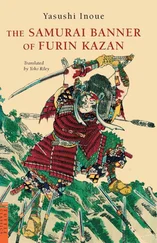Thomas Hoover - The samurai strategy
Здесь есть возможность читать онлайн «Thomas Hoover - The samurai strategy» весь текст электронной книги совершенно бесплатно (целиком полную версию без сокращений). В некоторых случаях можно слушать аудио, скачать через торрент в формате fb2 и присутствует краткое содержание. Жанр: Триллер, на английском языке. Описание произведения, (предисловие) а так же отзывы посетителей доступны на портале библиотеки ЛибКат.
- Название:The samurai strategy
- Автор:
- Жанр:
- Год:неизвестен
- ISBN:нет данных
- Рейтинг книги:5 / 5. Голосов: 1
-
Избранное:Добавить в избранное
- Отзывы:
-
Ваша оценка:
- 100
- 1
- 2
- 3
- 4
- 5
The samurai strategy: краткое содержание, описание и аннотация
Предлагаем к чтению аннотацию, описание, краткое содержание или предисловие (зависит от того, что написал сам автор книги «The samurai strategy»). Если вы не нашли необходимую информацию о книге — напишите в комментариях, мы постараемся отыскать её.
The samurai strategy — читать онлайн бесплатно полную книгу (весь текст) целиком
Ниже представлен текст книги, разбитый по страницам. Система сохранения места последней прочитанной страницы, позволяет с удобством читать онлайн бесплатно книгу «The samurai strategy», без необходимости каждый раз заново искать на чём Вы остановились. Поставьте закладку, и сможете в любой момент перейти на страницу, на которой закончили чтение.
Интервал:
Закладка:
For a time he merely knelt, silently contemplating the view and listening to the metrical drip of water from a bamboo spout situated just at the edge of the steps. Finally he turned and picked up his sumi stick, a block of dried ink made from soot, and carefully began to rub it against the concave face of an ancient inkstone, till its cupped water darkened to just the proper shade. When the fresh ink was ready, he wet a brush in a separate water vessel, dried it by stroking it against a scrap of old paper, dipped it into the dark liquid, and looked down.
This was the moment that demanded perfect composure, absolute control. Before him was a single sheet of rice paper, purest white, and now his hand held the brush poised. He was waiting for that instant when his senses clicked into alignment, when the feel of the brush merged with his mind, much the way a samurai's katana blade must become an extension of his own reflexes.
Although he would stroke only a few kanji characters, scarcely enough for a telex or a memo, the moment required discipline acquired through decades of practice. His Zen-style calligraphy allowed for no hesitation, no retouching. It must be dashed off with a spontaneity that was, in itself, part of the art. As with the swordsman, there could be no time for conscious thought, merely the powerful stroke guided by intuition. No decision that confronted him throughout a business day would demand half so much mental control, inner resolve.
Just then, at the far end of the pond, the first sun flickered through the wisteria. Suddenly, without his consciously knowing the exact moment had arrived, as a Zen archer's arrow must release itself of its own will, his hand struck. The dark tip of the brush pirouetted down the paper, starting at the left and laying down a mere five lines, twenty-two syllables. Inishie ni
Once held, ari kemu hito no it's said, moteri cho by men of long ago, omitsuwa wo my ancient prize- ware wa mochitari at last is near!
It was done.
He sighed, leaned back, and reached for the cup of green tea that rested beside him on the polished boards. The verse was in an archaic style, a few syllables longer than a haiku, modeled on an eight-hundred-year-old work by a court poet of the Heian era. The strokes were perfectly nuanced, the flow of the brush precise, the intuitive strength as natural as a waterfall.
Noda drained his tea, then rose to go back inside. His antique house was tastefully "empty": its tatami-floored rooms, measured in multiples of those standard three-by-six reed mats, were barren, a museum to times past. They also were open to each other, their sliding doors, fusuma, being pushed wide. The walls, too, were vacant expanses of white plaster with only an occasional mounted six-fold screen depicting poetry parties of the Heian era, that courtly civilization portrayed in The Tale of Genji. And there were no overhead lights, merely an occasional cypress andon floor lamp to augment the pastel glow of the rice-paper shop windows.
"Asa-han." He curtly ordered his gray-haired cook to bring breakfast, then turned to mount the ancient stairs.
"Hai." She nodded and was gone.
Although he kept the lower floor exactly as it had been two centuries past, the upstairs was a different matter entirely. It had been converted into a high-tech office, hooked through a maximum security TeleSystems TCS-9000 direct uplink (via the mid-Pacific Mareks-B satellite) to the mainframe of his new NEC information management system in the Kyoto headquarters, an augmented NEAX 2400 IMS, which handled voice, data, text, image. He had scarcely flipped on the system when the woman who managed his kitchen appeared, bowing, and deposited a tray bearing miso broth, rice, an uncooked egg, and more tea.
He grunted thanks as he was checking a CRT screen for the current rate on Fed funds, the cost of the money American banks lend each other overnight to meet reserve requirements. No surprises. Then he turned and cracked the egg over his rice, adding a leaf of dried nori seaweed. As he leaned back, chopsticks in hand, he quickly glanced through the Tokyo papers, followed by The Asian Wall Street Journal and the satellite edition of London's Financial Times. Finally he tossed them aside.
This was always the moment when he liked to take measure of the three photos standing in a row across the back of his teak desk. The first was his deceased wife Mariko-long-suffering, deferential, resignedly selfless. A model Japanese woman. He still thought of her with fondness, but as was expected of a Japanese helpmate, she always ran a distant second in his affections. His work came first.
The next picture was very different. This woman's face was white, her hair a lacquered wig, her lips a tiny red pout. Her name, Koriko, had been assigned years ago in the Gion district of Kyoto, and she was holding a three-stringed lute, a samisen, and intoning some classical melody from centuries past. These days she purchased thousand-dollar kimonos the way most office girls bought jeans, but she worked for the money. She was a geisha, a real one, an artist whose calling required years of training and commanded the awe of even the most modern Japanese. Like a prizefighter or a matador, she'd spent long painful hours perfecting style, technique, art. She had been Noda's one-time protegee, beneficiary of his patronage. Now, though, she had other "patrons." He still missed her, but the memory was fading.
The third photo was a face familiar to all of Japan's avid TV viewers-Akira Mori. She was wearing a dark blue Western suit, her hair a glossy pageboy cut, the conservative look of times past. It was the occasion of her graduation from the School of Law, Tokyo University (Tokyo Daigaku, or Todai as it's known), an important moment. Todai's alumni represent a network, a batsu, of the country's ruling elite, who compete with each other for the choicest, most prestigious government ministries. Although she had chosen a more visible career, she still relied heavily on her contacts in this governing clique, heads of the leading ministries, including Finance, Foreign Affairs, and of course the Ministry of International Trade and Industry, MITI.
Matsuo Noda himself had, in fact, once headed MITI, probably Japan's most powerful ministry. He came from ancient samurai stock-fittingly perhaps, since the bureaucrats of modern Japan are mostly of that class. The samurai caste, men who served a liege lord and were forbidden to engage in trade, were actually Japan's first public servants. In between civil wars they became sword-carrying bureaucrats. Many a modern bureau chief has ancestors who wore two swords and sliced up a peasant or a merchant now and then with impunity, which may help explain why the average citizen still views government officials with such nervous awe.
A Todai honors man himself, Noda was a natural for MITI, which runs what is in many ways a covert operation. The head offices are in a nondescript, soot-covered building of tinted glass and limestone near Tokyo's Hibaya Park, guarded by armed, helmeted members of Japan's National Police. Inside it's mostly open floors and lines of gray steel desks; no plush carpets and mahogany suites. MITI has twelve bureaus, each devoted to a major industrial sector. If its officials decide Japan's strategic interests would be served by a certain manufacturing group's cutting production, lowering prices, altering product lines, these "recommendations" are passed along. And it happens.
Noda began his career there by circulating through the different sections, "going around the track" as it's called, after which he proceeded to run the General Affairs office of various bureaus, by which time everybody had him picked for a mover, on the "elite course." Eventually he was promoted to section chief in the International Trade Bureau, next on to bureau chief, and finally at age forty-seven he made the top. Vice minister.
Читать дальшеИнтервал:
Закладка:
Похожие книги на «The samurai strategy»
Представляем Вашему вниманию похожие книги на «The samurai strategy» списком для выбора. Мы отобрали схожую по названию и смыслу литературу в надежде предоставить читателям больше вариантов отыскать новые, интересные, ещё непрочитанные произведения.
Обсуждение, отзывы о книге «The samurai strategy» и просто собственные мнения читателей. Оставьте ваши комментарии, напишите, что Вы думаете о произведении, его смысле или главных героях. Укажите что конкретно понравилось, а что нет, и почему Вы так считаете.












